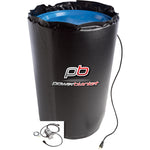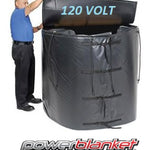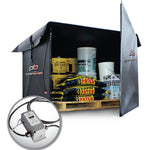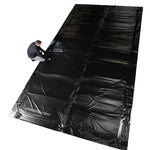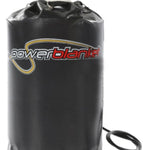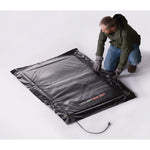You have no items in your shopping cart.
How to compare an infrared heater with a convection heater
Article At-a-Glance
What Are the Key Differences Between Infrared and Convection Heaters?
Infrared heaters provide efficient, targeted warmth by directly heating objects and people, making them ideal for smaller spaces and specific industrial applications, while convection heaters circulate warm air to evenly heat larger areas, offering a cost-effective solution for maintaining a consistent climate.
Key Takeaways
- Mechanism of Heating: Infrared heaters use radiant heat to directly warm objects and people, making them efficient for targeted heating. In contrast, convection heaters circulate warm air to heat entire spaces evenly, ideal for larger areas.
- Energy Efficiency: Infrared heaters are highly energy-efficient as they focus heat on specific areas without warming the surrounding air, leading to potential cost savings. Convection heaters, while effective for maintaining a consistent climate, may consume more energy due to the need to heat the entire space.
- Space Suitability: Infrared heaters are best suited for smaller spaces or specific industrial applications where direct heat is needed quickly. Convection heaters are more appropriate for larger rooms or environments requiring uniform temperature distribution.
- Practical Considerations: Infrared heaters offer quick heat delivery and are often easier to install, while convection heaters provide a more consistent climate but may require more time to reach desired temperatures.
- Industrial Applications: Infrared heaters excel in applications like drying materials and heating specific areas, whereas convection heaters are beneficial for processes needing even heat distribution, such as heating large rooms or preheating ovens.
When it comes to industrial applications, there are a lot of factors to consider when choosing the right type of heater. Two of the most common types of heaters are infrared heaters and convection heaters. But how do you know which one is right for your specific application? How do you compare an "infrared vs convection heater"? Keep reading to find out.
Both an infrared heater and a convection heater can run as electric heaters. And though there are many different heating options out there, we won't focus on infrared heat and convection heat specifically. When looking for energy usage, energy savings, and a heater that will be energy efficient, we are ready to show you why one of these two options will be the best.
What are Infrared Heaters?
This high-temperature application uses infrared heat to transfer energy or heat. Using this infrared energy with infrared panel heaters creates an efficient heating system that relies on radiant heating to warm items directly. The temperature transfer is influenced by the wavelengths from emitting cells. It warms the object or person by providing warmth from its surroundings. Infrared heaters are typically employed to produce thermal energy or to reduce heat loss. The air is delivered only to the focused area, which translates to warm air only to the parts needed. The design is designed for warmth, heat radiation, and comfort and allows you to have more control over the air temperature and process temperature overall.
Infrared heaters emit infrared rays that heat objects in the room without heating the air around them. This makes infrared heaters very efficient because they don't have to waste energy heating up space. Infrared heaters are ideal for smaller spaces because they can target specific objects or areas that need to be heated. Having the control to direct this heat energy creates a near instant heat application which speeds up your overall process.

Industrial applications for an infrared heater
There are many different ways that infrared heating is used to accomplish temperature control issues, speed up drying time, and utilize this specific type of heating element. The use of an infrared heater, like a Cata-Dyne Infrared Heater, can change some very crucial aspects of your business, specifically in saving you time and saving you money.

$1,861.20 USD
24" x 30" WX Series Infrared Gas Catalytic Heater 25,000 BTU
Some of the main industrial applications for infrared heaters are:
- Maintenance and repair operations
- Heating of warehouses, hangars, and production halls
- Thermal processing of food products
- Drying of building materials, paints, and coatings
- Preheating of air for ventilation systems

What are convection heaters?
A convection heating system can be referred to as a convection heater. Convection heaters are intended for use in heating air and circulating air. Convection heaters warm the air around them. Convection heating systems are cheaper and more efficient compared to other heat exchangers. Convection heaters are used to maintain a warm climate throughout the day. The heater heats everything from floor to ceiling. Convection heaters can increase room temperature more quickly than other heat exchangers.
Convection heaters work by circulating air around the room using a fan. As convection heaters heat the air as it comes into contact with the heater's coils or elements the hot air then can heat up the room more quickly. This type of heater is ideal for large rooms or spaces because it can distribute heat evenly throughout the room, heating the room efficiently.

Industrial applications for a convection heater
Similarly to an infrared heater, a convection heater, like a Norseman Convection Heater, can have many different applications. They can be used to improve upon many of your current temperature control processes and increase efficiency for your business. Especially when the focus needs to be on heating an item more directly instead of just heating the surrounding air.
Some of the main industrial applications for convection heaters are:
-Heating food in a restaurant kitchen
-Heating metal components in a factory
-Preheating ovens in a bakery
-Drying crops in a greenhouse
-Heating water for use in a spa or pool

Is infrared heat better than convection?
It really comes down to your application. Now that you know the difference between an infrared heater and a convection heater, you can make an informed decision about which type of heater is right for your industrial application. Making a choice to move away from conventional heaters and in the direction of a modern electric heating option, gives you a cost effective and time efficient option.
If you have any questions or need help choosing the right heater for your needs, our team at Heat Authority is always happy to help. Give us a call today!







